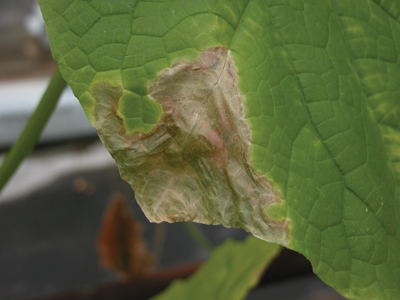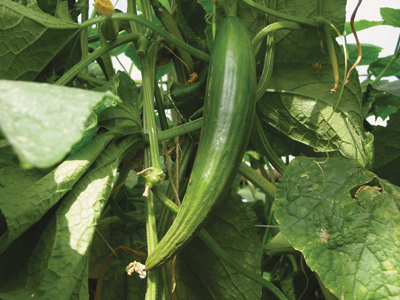
Features
Crop Protection
Inputs
Greenhouse Grower Notes: Managing gummy stem blight
April 30, 2009 By Gillian Ferguson
Gummy stem blight is a chronically occurring fungal disease that affects greenhouse cucumbers worldwide. It is caused by the fungus, Didymella bryoniae, which attacks all parts of the plant and can cause severe economic losses. Symptoms on stems consist of blackened lesions that may crack and produce a gummy, amber-coloured sap. Leaf symptoms include browning of leaf margins, and some of the affected margins can have V-shaped lesions, often with a yellow halo. Fruit symptoms are often not obvious externally, and usually consist of a tapering of the blossom end, which, when cut, is discoloured internally.
Gummy stem blight is a chronically occurring fungal disease that affects greenhouse cucumbers worldwide. It is caused by the fungus, Didymella bryoniae, which attacks all parts of the plant and can cause severe economic losses. Symptoms on stems consist of blackened lesions that may crack and produce a gummy, amber-coloured sap. Leaf symptoms include browning of leaf margins, and some of the affected margins can have V-shaped lesions, often with a yellow halo. Fruit symptoms are often not obvious externally, and usually consist of a tapering of the blossom end, which, when cut, is discoloured internally.

|
| Typical V-shaped lesion due to gummy stem blight on greenhouse cucumber leaf. Advertisement
|
As with any other disease or pest problem, management of gummy stem blight requires an integrated approach. Certainly, many growers are familiar with strategies necessary for minimizing the impact of D. bryoniae. This article focuses on, and serves as a reminder of, three important cultural practices and their effects on gummy stem blight:
• Manipulation of the climate.
• Nutrition.
• Pruning.
The information provided is based on greenhouse cucumber research done in Denmark during 1985-1987. All crops were grown in rockwool, planted in January and terminated in late summer.

|
|
| Tapering of cucumber fruit due to gummy stem blight infection.
|
Manipulation of the greenhouse climate to prevent or minimize periods of leaf wetness is critical to reducing the development and spread of gummy stem blight. Leaf wetness is particularly affected by the transition from night to day temperature before sunrise. A properly implemented transition will reduce gummy stem blight infections by preventing dew formation on the plants. Such a transition is, ideally, best done by raising the night temperature to day levels about three hours before sunrise, thereby providing sufficient time for plants to warm up prior to sunrise.
The Danish research showed that when such a temperature regime was applied, the percentage of internal fruit rot was significantly lower when compared with a transition that was dependent on light. This work is also supported by a Dutch pathologist who found that the incidence of stem and fruit rot due to gummy stem blight was substantially reduced by heating the glasshouse to the day setpoint before sunrise.
It is likely that drier conditions restrict the release of airborne spores, resulting in a lower occurrence of infection. The later the transition to day temperature takes place, the longer the periods of high air humidity, and correspondingly, the more spores are released and the higher the incidence of stem infections and internal fruit rot. In addition, spores only need about a one-hour period of leaf wetness to initiate an infection.
Fertilizer solutions with higher electrical conductivities (ECs) with adequate calcium levels are associated with a reduced incidence of internal and external fruit rot, possibly by streng-thening the outer tissues of the fruit. However, solution ECs do not appear to affect the incidence of lesions on the stem.
Reduced pruning, consisting of leaving wilted leaves and shoots on the plant, is associated with a higher incidence of external fruit rot and stem infections. The decaying tissue from wilted leaves left on the plants provides considerable organic nutrients for the fungus, leading to increased spore production and better conditions for establishment of new infections. Thinning of fruits does not seem to affect incidence of both internal and external fruit rot.
Manipulation of the greenhouse climate to minimize incidence of leaf wetness, having optimum ECs for the cultivars being grown, and maintaining a well-pruned crop will all contribute to reducing the impact of gummy stem blight on greenhouse cucumbers.
Gillian Ferguson is the greenhouse vegetable IPM specialist with the Ontario Ministry of Agriculture, Food and Rural Affairs in Harrow. • 519-738-1258, or gillian.ferguson@ontario.ca
Print this page